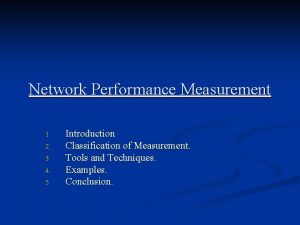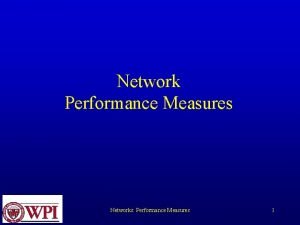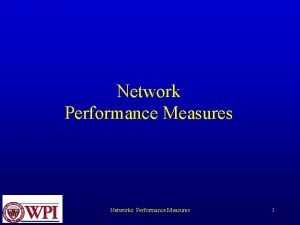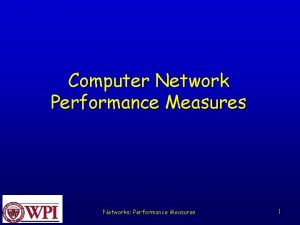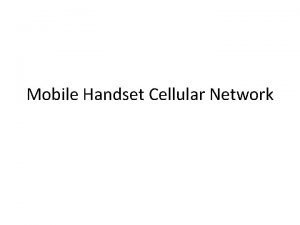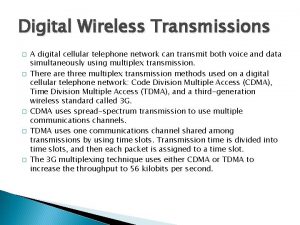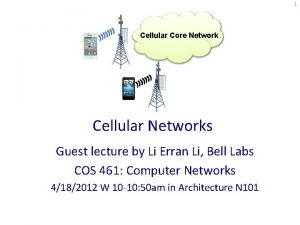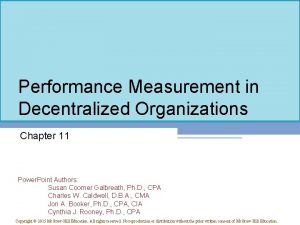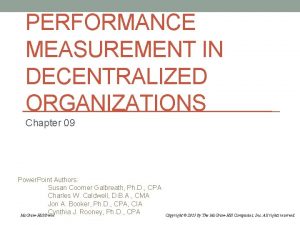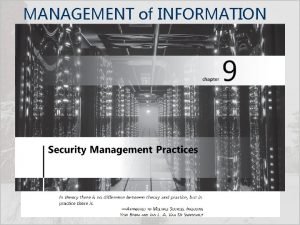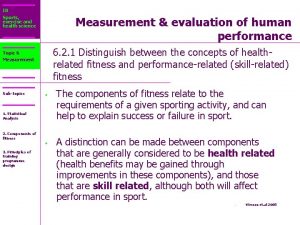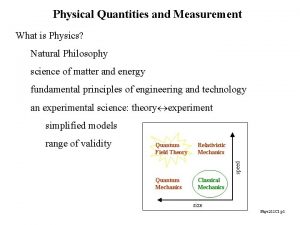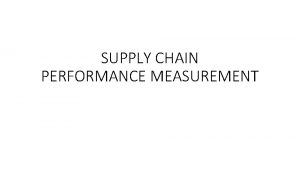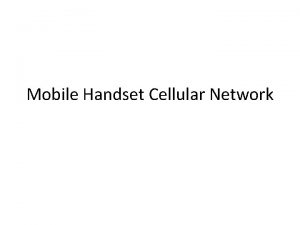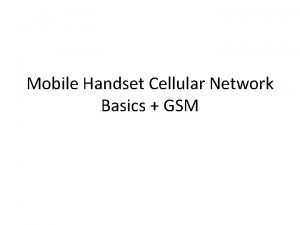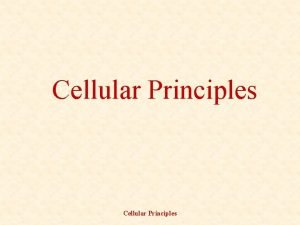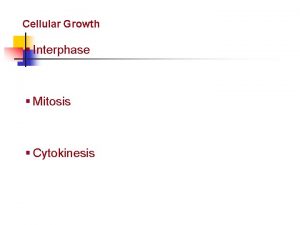Cellular Network Performance Measurement Class Presentation for CS




























































- Slides: 60

Cellular Network Performance Measurement Class Presentation for CS 234 - Advanced Networks by Pramit Choudary, Balaji Raao & Ravindra Bhanot (Group 18) Instructor: Professor Nalini Venkatasubramanian 05/10/2012

Papers considered • Paper 1: Understanding Traffic Dynamics in Cellular Data Networks by U. Paul, A. Subramanian, M. Buddhikot, S. Das, IEEE INFOCOM 2011, Shanghai, China • Paper 2: An Untold Story of Middleboxes in Cellular Networks, SIGCOMM 2011, Toronto, Ontario, Canada (NOTE: Please refer to the relevant papers listed above in place of ‘paper 1’ or ‘paper 2’ found in the presentation slides. ) 2

Background - Internet/Data Access? • Dial-up connection • Broadband (DSL, Cable Internet, Fiber Optics) • Wi-Fi (IEEE 802. 11 standard) & Wi. MAX (IEEE 802. 16 standard) • Mobile Broadband using 2. 5 G, 3 G, 4 G technologies Each claim to cater different data rates, ranges in operation, needs of end user/application, energy savings, etc using different protocol designs, business strategies, network deployments and many more. 3

Background - Cellular Networks and interconnecting subsystems 4 G: Fourth generation of cell phone mobile communications standard 3 G: Third generation of cell phone mobile communications standard Femtocell: Small cellular base station designed for use in a home or small business IMS: IP Multimedia Subsystem, used to provide mobile and fixed multimedia services Image courtesy: radisys. com 4

Background - Broadband Cellular Networks • E. g. HSPA - Mobile telephony protocols used in 3 G cellular networks for mobile data access. • Broadband cellular access becoming most common and pervasive world-wide. • Fueled by introduction of user-friendly smart phones, notebooks, tablets, e. Book readers. 5

Background - A look at smartphone technology Courtesy: Technology Review, Published by MIT, May 9 th 2012 6

Background - Broadband Cellular Networks • Has led to innovative & flashy mobile applications like gaming, video streaming, social networking, etc. • Use of several and various types of middleboxes to manage the scarce resources (because same resources are shared mostly) in the network and to protect them e. g. Network Address Translation (NAT) boxes, firewalls, etc. 7

Background - On usage of middleboxes • Many times, cellular network middleboxes (deployed by carriers like AT&T, T-Mobile) and mobile applications (application developers) – managed independently. • Knowledge mismatch -> End-to-end performance degradation, Increase in energy consumption, Introduce security vulnerabilities. • E. g. Carrier setting aggressive timeout for inactive TCP connections in the firewall and disrupting long lived and occasionally idle connections maintained by applications like instant messaging, push-based email, etc. • Need for understanding the effects of middleboxes in cellular network. • Paper 2 specifically focuses on NAT boxes, their policies & firewall and its policies. 8

Background - Broadband Cellular Networks (Contd. ) • Expectations in increase in the volume of data seen exponentially. • Supporting such an increase requires good understanding of traffic dynamics and its impact on resource allocation on the service provider’s network. • Leading to better resource planning, network designs, spectrum allocation and energy savings. 9

Background - Broadband Cellular Networks (Contd. ) • For some exciting numbers, refer to a white paper by Cisco on global mobile data traffic forecast for 2011 -2016: http: //www. cisco. com/en/US/solutions/collat eral/ns 341/ns 525/ns 537/ns 705/ns 827/white_ paper_c 11 -520862. html 10

Paper 1 - Short Summary • Discuss traffic dynamics specific to 3 G cellular networks. • End user perspective: Study subscriber traffic patterns, number of distinct base stations visited by subscribers, relate mobility and traffic, subscriber temporal activity & relate subscriber activity and traffic. • Network component perspective: Study aggregated load at base stations, base station load distributions, spatial characteristics, temporal characteristics and spatio-temporal characteristics of network load at base stations. 11

Paper 1 - Short Summary (Contd. ) • Provide implications on the measurements and observations made. • Test conducted in 2007 for a week over a US nation-wide network with thousands of base stations and with entire subscriber base (order of hundreds of thousands i. e. close to a million). • Performed measurements on all generated data packet headers (not including payloads) and on signaling & accounting packets. 12

Paper 1 - Subscriber Traffic Dynamics • Subscriber Traffic Distribution: KEY OBSERVATIONS • Heavy users: Users who generate as high as 10 GB of traffic per day (10^5 times median). • Light users: Users who generate less than 1 KB per day. • CDF shifts left over weekends. Fig. CDF of total traffic volume per subscriber per day. INFERENCE • Less traffic on weekends relative to traffic on working days. 13

Paper 1 - Subscriber Traffic Dynamics • Subscriber Traffic Distribution (Contd. ): KEY OBSERVATIONS • 1% of the subscribers create more than 60% of the daily network traffic. • 10% of subscribers create 90% of the daily network traffic. Fig. CDF of normalized traffic volume over the percentage of subscribers per day. INFERENCE • Imbalance in network usage with few subscribers (10%) using much of the network resources. 14

Paper 1 - Subscriber Traffic Dynamics • Implications of Subscriber Traffic Distribution: 1) An unlimited data plan with flat rate pricing is not efficient both from the carrier’s perspective and subscriber’s perspective. 2) CDF graphs shown in previous two slides can be used to create a ‘tiered’ rate plan for data. 3) Tiered rate plan deals with providing different pricing options based on data usage. 15

Paper 1 - Subscriber Traffic Dynamics • Implications of Subscriber Traffic Distribution (Contd. ): 4) To alleviate the problem of high volume subscribers creating poor experience for other subscribers, high volume subscribers can be provided with some incentives. 5) Paper doesn’t consider optimal pricing schemes based on subscriber usage and network capacity. It only provides heuristic implications for subscriber traffic distribution. 16

Paper 1 - Subscriber Traffic Dynamics • Subscriber Mobility (i. e. Base Stations Visited): Fig. CDF of number of distinct base stations visited by a subscriber each day. KEY OBSERVATIONS • Distribution similar on weekdays and different on weekends. • 60% of users are stationary (i. e. constrained within a cell) and over 95% of users travel across less than 10 base stations in a day. • Highly mobile users (who visit more than 50 distinct base stations in a day) are about 0. 01%. 17

Paper 1 - Subscriber Traffic Dynamics • Subscriber Mobility (i. e. Base Stations Visited): INFERENCE • Tendency of lesser degree of mobility on weekends. • In terms of the number of distinct base stations visited, the overall mobility is low. Fig. CDF of number of distinct base stations visited by a subscriber each day. 18

Paper 1 - Subscriber Traffic Dynamics • Subscriber Mobility (Radius of Gyration): Fig. CDF of radius of gyration. • Radius of Gyration is the linear size occupied by a subscriber’s trajectory. Requires certain duration of time (t) for computation from subscriber’s trajectory. • It is basically a root mean square value. • Calculated with respect to the center of mass point of the user’s trajectory. 19

Paper 1 - Subscriber Traffic Dynamics • Subscriber Mobility (Radius of Gyration): KEY OBSERVATIONS: • 53% of subscribers are practically static and almost 98% of the subscribers have radius of gyration less than 100 miles. Fig. CDF of radius of gyration. INFERENCE: • Shows the low level of mobility of majority of subscribers (half of them). 20

Paper 1 - Subscriber Traffic Dynamics • Subscriber Mobility (Radius of Gyration): Fig. Radius of gyration versus duration of computation for subscribers categorized into 4 groups according to their final rg at the end of seven-day period. KEY OBSERVATIONS: • Radius of gyration on an average comes to a saturation point in just few days (based on no. of hours). Saturation indicates that some sort of boundary in the movement area has been reached. Quick saturation measured in terms of ‘return probability’ in next slide. • Users with larger radius of gyration need longer time to 21 saturate.

Paper 1 - Subscriber Traffic Dynamics • Subscriber Mobility (Radius of Gyration): KEY OBSERVATIONS: • Distribution has peaks at 24 th, 48 th and 72 nd hours. Fig. Probability distribution of time to returning to the same location. INFERENCE: • Periodic nature of human mobility with a 24 hour period (like coming back home) and tendency to return to the same location periodically. This infers the saturation of radius of gyration. 22

Paper 1 - Subscriber Traffic Dynamics • Subscriber Mobility (Radius of Gyration): Fig. Probability of finding a subscriber at different locations that are ranked on the basis of their frequency of visits. Shows four categories of subscribers who visit 5, 10, 30 and 50 distinct base stations. KEY OBSERVATIONS: • Location with rank, L = 1 indicates the most visited base station for a subscriber. • Subscribers spend 30% of their time in the top two preferred locations. INFERENCE: • Subscribers are found at their favorite location with high probability even there is high 23 mobility among them.

Paper 1 - Subscriber Traffic Dynamics • Inferences on Subscriber Mobility so far 1) Large fraction of subscribers have limited mobility (roughly half of them are static moving within just 1 mile). 2) Subscriber mobility also exhibits periodic behavior with high probability of returning to same base station at same time of the day. 3) Overall mobility is predictable. 4) More mobile users tend to generate more traffic. 24

Paper 1 - Subscriber Traffic Dynamics • Implications on Subscriber Mobility 1) Idea of caching content and delivering it to subscribers who exhibit a predictable mobility behavior - Innovative cloud-based content delivery applications. 2) Optimizing the location based services and targeted ad-services through predictable mobility pattern. 25

Paper 1 - Subscriber Traffic Dynamics • Relating subscriber mobility and traffic they generate: Fig. CDF of traffic generated per day by subscribers based on number of locations (base stations) visited in a day. Fig. CDF of traffic generated per day by subscribers based on radius of gyration. 26

Paper 1 - Subscriber Traffic Dynamics • Relating subscriber mobility and traffic they generate: KEY OBSERVATIONS FROM PREVIOUS SLIDE: • Though the plot lines appear similar, they differ in traffic volume for different number of base stations visited and traffic volume for different radii of gyration. INFERENCE: • More traffic is generated by more subscribers. • Median traffic generated by subscribers in the highest mobility category is roughly twice that of the subscribers in the lowest mobility category. 27

Paper 1 - Subscriber Traffic Dynamics • Implications relating to subscriber mobility and traffic they generate: 1) Planning resources dynamically based on traffic generated by subscribers specific to subscriber timings of movements. 2) Spectrum management based on timings of traffic generated and in different cells. 28

Paper 1 - Subscriber Traffic Dynamics • Subscriber Temporal Activity: It is the number of days (or hours) in a week (or in a day), subscribers generate traffic. Fig. CDF of number of hours among peak hours (8 AM to 8 PM) subscribers generate traffic. KEY OBSERVATIONS • About 28% of the subscribers generate traffic only in single hour during the peak hours. • A typical subscriber (i. e. median) is active in the 4 different hours during the peak hours. (Consider a straight line -50% line- across the 29 graph)

Paper 1 - Subscriber Traffic Dynamics • Subscriber Temporal Activity: Fig. CDF of number of hours among peak hours (8 AM to 8 PM) subscribers generate traffic. INFERENCE: • Large fraction of subscribers generate traffic only in few hours within a day. • That is, more of number of subscribers generating traffic is for a lesser duration of time (for the week / for a day). 30

Paper 1 - Subscriber Traffic Dynamics • Subscriber Temporal Activity: Airtime: Amount of time a subscriber holds onto a radio channel regardless of whether it communicates or not. Fig. CDF of airtime among subscribers. KEY OBSERVATIONS: • Median usage is about 100 sec. • For all 24 hrs (86, 400 sec), very few i. e. less than 1% of subscribers use the radio channel. • Weekend usage again lower compared to weekday usage. 31

Paper 1 - Subscriber Traffic Dynamics • Relating subscriber temporal activity and traffic they generate: KEY OBSERVATIONS: • A typical heavy user appears in 4 to 6 different hours during peak hours in the days they generate traffic. Fig. CDF of occurrence for heavy users (within top 5000 in atleast one day in the week with regard to traffic) in peak hours. INFERENCE: • Most heavy users are actually quite sporadic in traffic generation and not habitual. 32

Paper 1 - Subscriber Traffic Dynamics • Relating subscriber temporal activity and traffic they generate: Effective bit rate is the ratio of amount of actual traffic generated by the subscribers to the airtime. Metric for efficient radio channel use. Fig. CDF of effective bit rate for subscribers categorized by traffic generated per day. KEY OBSERVATIONS: • Subscribers generating less traffic (<= 30 KB) have poorer effective bit rate compared to more traffic ones. May be due to the kind of application they use (next slide). 33

Paper 1 - Subscriber Traffic Dynamics • Relating subscriber temporal activity and traffic they generate: Fig. Effective bit rate for popular TCP based applications. KEY OBSERVATIONS: • P 2 P and http: yahoo have the best channel efficiencies. • VPN, https and http for Google, Microsoft have poorest efficiencies. INFERENCE: • Enterprise applications generate less traffic compared to other applications for the same airtime. • All applications have significantly poorer effective bit rates 34 compared to nominal rates (phy

Paper 1 - Subscriber Traffic Dynamics • Relating subscriber temporal activity and traffic they generate: Fig. Effective bit rate for popular TCP based applications. REASONING for INFERENCE: • Enterprise applications (VPN) tend to use network sporadically like keep-alive messages and typically not high throughput applications. • Considering dormancy/sleep modes, effective bit rate is poor for VPN-like applications. • High throughput applications like P 2 P use the channel better. 35

Paper 1 - Subscriber Traffic Dynamics • Implications on effective bit rates: 1) Inefficiency in the usage of the radio channel airtime drives the need for an innovative protocol to use wireless channel efficiently. 2) Inefficiency arises because of wiredinternet protocols used to access wireless channel and hence better network protocols need to be designed. 36

BASE STATION TRAFFIC DYNAMICS We focus on network behavior as a whole or in terms of network components (base stations) instead of focusing on subscribers. • • Aggregate Load Base Station Load Distribution Spatial Characteristics Temporal Characteristics – Load – Auto-correlation • Spatiotemporal Characteristics 37

BASE STATION TRAFFIC DYNAMICS - Contd. Aggregate Load: • Total traffic split into upload and download for each day of the week. • Favorite weekends see a lesser load • Downloads dominate relative to uploads with more than 75% of daily load coming from download traffic 38

BASE STATION TRAFFIC DYNAMICS- Contd. Aggregate Load: Load on the network is relatively low in the early morning hours, and roughly similar during the day and the evening. 39

BASE STATION TRAFFIC DYNAMICS- Contd. Base Station Load Distribution: Volume of daily traffic load for each base station 80% of the base stations are loaded in the range of 1 - 100 MB per day and 10% of the base stations are highly loaded (more than 100 MB per day). • shows the CDF of daily base station loads normalized by the total network load. • 10% of the base stations experience roughly about 50 -60% of the aggregate traffic load. In both cases, weekend behavior is slightly different than weekday behavior. The load imbalance seems more pronounced in weekends. Great imbalance of the base station loads indicates that a more careful cell planning is possibly needed. Network providers 40 may use smaller cells or microcells at the hotspots to even out the imbalance.

BASE STATION TRAFFIC DYNAMICS- Contd. Spatial Characteristics • Goal is to identify whether or how much spatially correlated the network load is. • Estimates can potentially help the provider to allocate resources appropriately. • Use of Voronoi cells to conduct the experiments • Voronoi cell corresponds to the geographic region of each base station’s coverage. E. g. 10 shops in a flat city and their Voronoi cells 41

BASE STATION TRAFFIC DYNAMICS- Contd. More on Voronoi cells: • Voronoi cells in certain areas (city centers) signifying some degree of cell planning. • We can readily see again that the cells are not uniformly loaded in space. The load differentials can extend several orders of magnitude. Region 1 • There does appear to be some degree of negative correlation between the Voronoi cell size and load. • Large Voronoi cells mean sparsely located base stations, implying sparer population density. No significant spatial correlation between adjacent cells is observed via visual inspection of similar plots for all days. Region 2 42

BASE STATION TRAFFIC DYNAMICS- Contd. Temporal Characteristics: correlation or predictable relationship between signals observed at different moments in time. 1. Load: • Hourly aggregate load of the entire network and highly loaded base stations. • Aggregate network load exhibits a nice periodic behavior with relatively high loads during the day and the lowest load during midnight. • Individual base station loads do not show that much periodicity. • load curve varies significantly among individual base stations with their peaks occurring at different times of the day. 43

BASE STATION TRAFFIC DYNAMICS- Contd. Auto-correlation: • Rigorous analysis of the periodic behavior describing the network load is done using temporal correlation for a load metric. • Helps in understanding the underlying trends and seasonal variations better. • Auto-correlation function of the time series at different lags. • Notice the plot shows a high degree of temporal correlation. • High peaks occur at 24 hour intervals and low peaks at 12 hour intervals. • Isn’t this consistent with diurnal human activity patterns. 44

BASE STATION TRAFFIC DYNAMICS- Contd. Spatiotemporal Characteristics: • Use of Moran I to investigate spatial behavior. • Moran's I is a measure of spatial auto correction. • Spatial autocorrelation is characterized by a correlation in a signal among nearby locations in space. Spatial autocorrelation is more complex than onedimensional autocorrelation because spatial correlation is multi-dimensional (i. e. 2 or 3 dimensions of space) and multi-directional. • It’s defined as �� is the hourly load on a base station(random variable). --�� (x bar) mean of x ���� ’s are the observations. ������ is the weight associated with each pair (���� , ���� ) �� is the number of observations. 45

BASE STATION TRAFFIC DYNAMICS- Contd. More on Moran I: • Binary weights: ������ = 1, when the base stations are in close proximity (a threshold of 2 miles is used), else ������ = 0. • Moran’s I metric is plotted for hourly loads of all base stations in the network on a temporal scale. • Periodic behavior with a diurnal cycle is interesting. • Appears that while temporal usage patterns of base stations may be very different and might even miss periodicity there is a general tendency for proximate base station loads to be more correlated when the loads are high. • Correlation is fairly small, rarely exceeding 0. 15. • Min close to zero, showing almost independent loading behavior around midnights when generally the loads are 46 small.

Implication of variability in Base station Load • High degree of variability in base station loads has important implication on spectrum allocation and energy saving schemes in the network. • Adaptively turning on/off certain carriers or radios in base stations based on the load experienced need to be developed. • Peak hours of different cells vary a lot • Dynamic allocation of spectrum resources to highly loaded cells during their peak hours • Future Work: model the demand characteristics on different cells in cellular data networks based on measurements for a long period of time and feed the model as inputs to dynamic spectrum allocation algorithms. Study the observation 47

Paper 2 – Net. Piculet – Untold Story of middleboxes • Cellular networks becoming more and more ubiquitous and pervasive. • Two major players involved in such networks – - Network providers - Application developers • Cellular Networks also face problems similar to their Internet counterparts such as IP address space depletion and security loopholes • Moreover cellular networks have limited resources • To make best use of their limited resources, number of middleboxes deployed by providers to enforce policies 48

Net. Piculet • An Android Application opened to mret place in January 2011 in order to record policies • Major policies tested are NAT and Firewall • Tested over 6 continents and 107 different carriers. • Made lucrative by making the user know his network shortcomings and loopholes 49

Net. Piculet - System Architecture 50

NAT traversal • NAT traversal is a general term for techniques that establish and maintain Internet protocol connections traversing a NAT gateway • IPv 4 address space depleted and number of users increasing. • Also allows hiding of end clients behind NAT routers and thus increases security • Many filtering policies implemented at NAT gateways which was the aim of Net. Piculet to find out. 51

NAT mapping schemes • NAT middlebox maps an external endpoint based on the TCP 5 tuple (protocol, local-addr, local-process, foreign-addr, foreignprocess) • Mapping can be any one of the following: - Independent : - external endpoint remains the same - Address and Port(delta) – external endpoint changes when destination endpoint changes - Connection(delta) – External endpoint changes for each new connection [delta – increment in external port number for every new connection] • Port number predicted in order to test with stream of packets for new connections. 52

NAT Policies • Nat properties: - End point filtering - TCP state tracking - Filtering Response - Packet mangling • NAT characteristics: - Time dependent NAT mapping – has advantages as well as disadvantages and hence a compromised value has to be decided depending upon tradeoff - Multiple NAT boxes – system complexity increases 53

Summary of results of NAT Policies • Discovered a previously unknown NAT mapping scheme and implemented a corresponding traversal scheme which succeeds with high probability. • A single client may encounter multiple NAT boxes due to load balancing and hence care should be taken to maintain mapping during the traversal. • Some of the carriers assign random ports for connections which is worst for NAT mapping and traversal. Birthday paradox used to resolve the mapping but for P 2 P applications, it is better to use a consistent mapping scheme. 54

Firewall • Required to protect end users from malicious attacks such as Do. S, Battery drain-out, etc • Implemented at middleboxes inline with NAT. • Methodology used for testing: - Testing IP spoofing - Testing stateful Firewall - Testing TCP connection timeout - Testing Out-of-order Packet Buffering 55

Firewall Policies 56

Firewall Policies – Implications and Recommendations • Energy impact of TCP connection timeout • Performance and Energy impact of buffering - Disabling TCP fast retransmit - Bad interaction with Protect against wrapped sequence - Bad interaction with TCP Forward- RTO recovery • Exploiting large sequence number window • Flaws with closing TCP connections 57

Firewall Policies – Effect on Download time 58

Firewall Policies – Effect on Energy Consumption 59

Summary of Firewall Policies • 4 out of 60 cellular networks allow IP spoofing making the user vulnerable • Nearly 15 % of carriers set TCP timeout less than 10 minutes increasing energy consumption. SDK suggested to be used by developers to maintain uniformity. • TCP out of order buffering causes degraded performance and energy waste in some cases. So a tradeoff has to be decided between performance and security. 60
 Network performance measurement tools
Network performance measurement tools Network performance measurement tools
Network performance measurement tools Network performance measurement
Network performance measurement Network performance measurement in computer networks
Network performance measurement in computer networks Router node
Router node Performance criteria of cellular system
Performance criteria of cellular system Cellular network range
Cellular network range A satellite used in a cellular telephone network
A satellite used in a cellular telephone network Cellular core network
Cellular core network Performance measurement in decentralized organizations
Performance measurement in decentralized organizations Performance measurement in decentralized organizations
Performance measurement in decentralized organizations Security performance management
Security performance management 3 approaches to measuring performance
3 approaches to measuring performance Comparative performance measurement system
Comparative performance measurement system Defining performance and choosing a measurement approach
Defining performance and choosing a measurement approach Progress and performance measurement and evaluation
Progress and performance measurement and evaluation Measurement and evaluation in human performance 5e download
Measurement and evaluation in human performance 5e download Vertical jump adalah
Vertical jump adalah Quantum performance measurement
Quantum performance measurement Evaluation in progress
Evaluation in progress Vector network analyzer block diagram
Vector network analyzer block diagram Physical quantities and measurement class 6 worksheet
Physical quantities and measurement class 6 worksheet Kontinuitetshantering i praktiken
Kontinuitetshantering i praktiken Novell typiska drag
Novell typiska drag Nationell inriktning för artificiell intelligens
Nationell inriktning för artificiell intelligens Ekologiskt fotavtryck
Ekologiskt fotavtryck Shingelfrisyren
Shingelfrisyren En lathund för arbete med kontinuitetshantering
En lathund för arbete med kontinuitetshantering Underlag för särskild löneskatt på pensionskostnader
Underlag för särskild löneskatt på pensionskostnader Tidbok yrkesförare
Tidbok yrkesförare A gastrica
A gastrica Densitet vatten
Densitet vatten Datorkunskap för nybörjare
Datorkunskap för nybörjare Stig kerman
Stig kerman Mall för debattartikel
Mall för debattartikel För och nackdelar med firo
För och nackdelar med firo Nyckelkompetenser för livslångt lärande
Nyckelkompetenser för livslångt lärande Påbyggnader för flakfordon
Påbyggnader för flakfordon Formel för lufttryck
Formel för lufttryck Svenskt ramverk för digital samverkan
Svenskt ramverk för digital samverkan Lyckans minut erik lindorm analys
Lyckans minut erik lindorm analys Presentera för publik crossboss
Presentera för publik crossboss Teckenspråk minoritetsspråk argument
Teckenspråk minoritetsspråk argument Vem räknas som jude
Vem räknas som jude Klassificeringsstruktur för kommunala verksamheter
Klassificeringsstruktur för kommunala verksamheter Fimbrietratt
Fimbrietratt Bästa kameran för astrofoto
Bästa kameran för astrofoto Centrum för kunskap och säkerhet
Centrum för kunskap och säkerhet Lågenergihus nyproduktion
Lågenergihus nyproduktion Mat för unga idrottare
Mat för unga idrottare Verktyg för automatisering av utbetalningar
Verktyg för automatisering av utbetalningar Rutin för avvikelsehantering
Rutin för avvikelsehantering Smärtskolan kunskap för livet
Smärtskolan kunskap för livet Ministerstyre för och nackdelar
Ministerstyre för och nackdelar Tack för att ni har lyssnat
Tack för att ni har lyssnat Vad är referatmarkeringar
Vad är referatmarkeringar Redogör för vad psykologi är
Redogör för vad psykologi är Borstål, egenskaper
Borstål, egenskaper Atmosfr
Atmosfr Borra hål för knoppar
Borra hål för knoppar Orubbliga rättigheter
Orubbliga rättigheter
